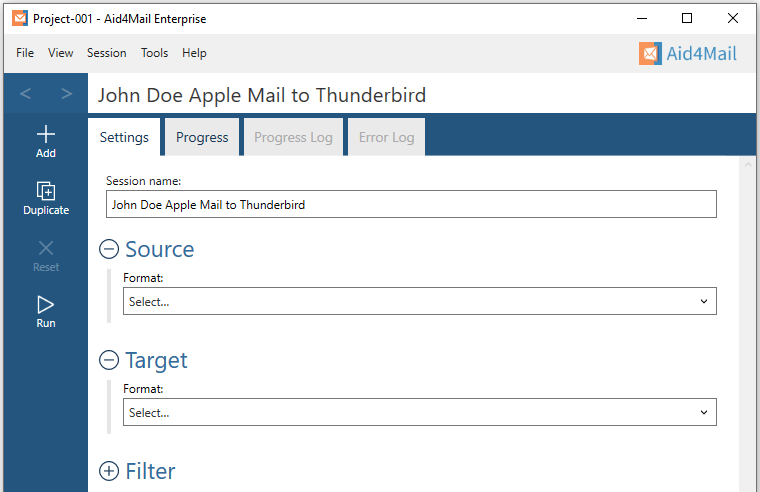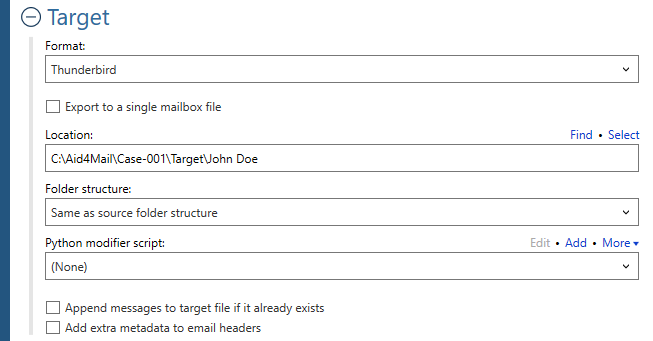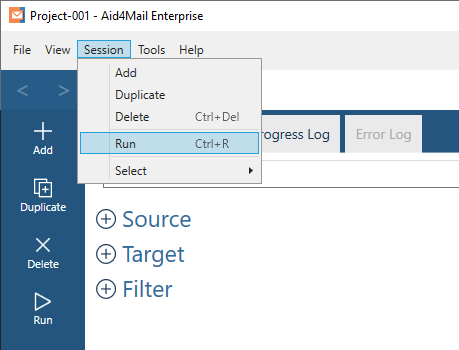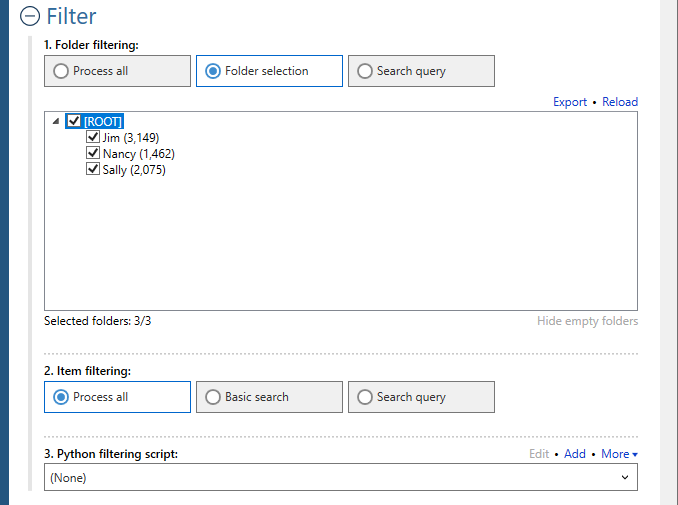Welcome to Fookes Software’s support portal
How to convert Apple Mail (EMLX) to Thunderbird (without data loss)
Please follow the steps below. For any setting that’s not specifically mentioned, you can either use the default (preset) value or consult the Aid4Mail user guide for details.
Step 1: Open Aid4Mail’s settings

- In Aid4Mail, select the Settings tab.
- Update the Session name so it describes the task at hand. In this example, we will be converting John Doe’s Apple Mail (EMLX) files to Thunderbird files so we’ve entered John Doe Apple Mail to Thunderbird as the session name.
- Below the session name there are three sections: Source, Target and Filter. Each can be displayed or hidden by selecting the +/- symbol next to the section heading. This tutorial requires them all to be displayed.
Step 2: Set Apple Mail as your source

- In the Format list, select Apple Mail (EMLX files).
- Set the Location of your Apple Mail EMLX files, either writing it directly in the field or by using the Select button to browse your file system.
- Choose whether to Remove journaling envelope if your email files are journaled.
Step 3: Set Thunderbird as your target

- In the Format list, select Thunderbird.
- Choose whether to Export to a single mailbox file, or create one mbox file for every mail folder.
- Set the Location where you want your Thunderbird file(s) to be saved. You can write directly in the field or use the Select button to browse your file system. If you’re exporting to a single mailbox file, set a file name (with or without an extension), otherwise set a directory location.
- Select an option for the Folder structure of the exported mail. Usually you’ll want to keep it the same as the original, so choose Same as source folder structure.
- If you want to add to existing Thunderbird files, choose Append messages to target file if it already exists.
- Add extra metadata to email headers when your chosen target format or settings would otherwise result in data loss. For example, if the target format doesn’t support some of the source format’s header fields. Or if the original folder structure would be lost due to your settings. With this option, the data is not lost but instead added to the email headers.
Step 4: Set your filter (optional)
- Under Folder filtering, pick Folder selection. Your Apple Mail EMLX files folder structure will appear in the box below.
- Select the folders you want Aid4Mail to process. The others will be skipped.
Step 5: Run your Apple Mail to Thunderbird conversion

Select the Run button or Session > Run from the menu. Aid4Mail will convert your Apple Mail EMLX files to Thunderbird. It will automatically open the Progress tab so you can monitor what’s going on. Once finished, you will find full reports in the Progress log and, if relevant, the Error log.
That’s it!
We hope you found this tutorial helpful in showing you why Aid4Mail is the best Apple Mail to Thunderbird converter on the market. As shown above, Aid4Mail can migrate Apple Mail to Thunderbird quickly and reliably. Don’t forget as well that we have been developing Aid4Mail for over 20 years and have perfected how Aid4Mail can import Apple Mail to Thunderbird without issues and preserving the folder structure and metadata.
If you’re looking for further information, first take a look through the Aid4Mail user guide and our knowledge base articles.
If you still have questions, don’t hesitate to contact our award-winning Helpdesk.
If you’d like to buy an Aid4Mail license, please visit the online store.
Or if you’d like to try Aid4Mail first before purchasing, download a free trial and export Apple Mail to Thunderbird today. We want you to have full confidence in Aid4Mail!
